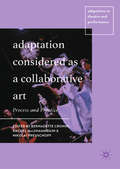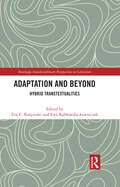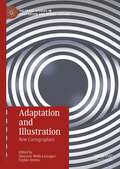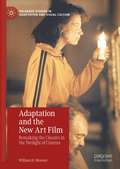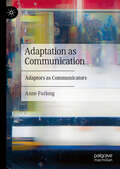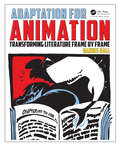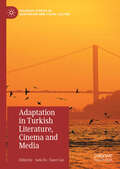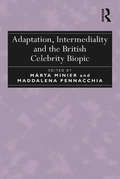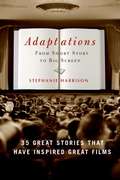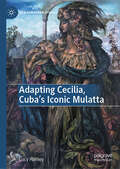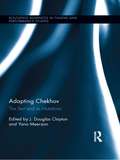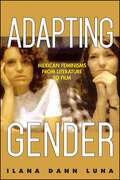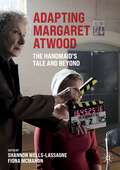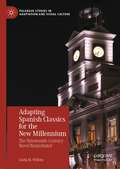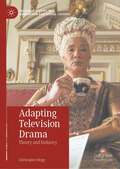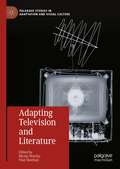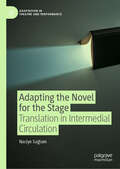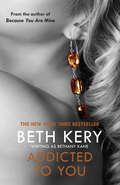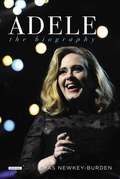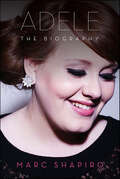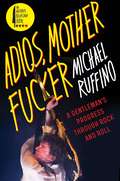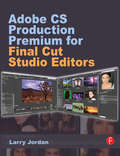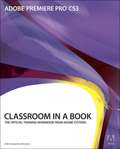- Table View
- List View
Adaptation Considered as a Collaborative Art: Process and Practice (Adaptation in Theatre and Performance)
by Bernadette Cronin Rachel MagShamhráin Nikolai PreuschoffThis book examines the processes of adaptation across a number of intriguing case studies and media. Turning its attention from the 'what' to the 'how' of adaptation, it serves to re-situate the discourse of adaptation studies, moving away from the hypotheses that used to haunt it, such as fidelity, to questions of how texts, authors and other creative practitioners (always understood as a plurality) engage in dialogue with one another across cultures, media, languages, genders and time itself. With fifteen chapters across fields including fine art and theory, drama and theatre, and television, this interdisciplinary volume considers adaptation across the creative and performance arts, with a single focus on the collaborative.
Adaptation and Beyond: Hybrid Transtextualities (Routledge Interdisciplinary Perspectives on Literature)
by Eva C. Karpinski Ewa Kębłowska-ŁawniczakThis interdisciplinary collection focuses on recent adaptations, both experimental and popular, that put hybridity, transtextuality, and transmediality at play. It reframes adaptation in terms of the transmedia concept of "world-building," which accurately captures the complexity and multidirectionality of contemporary scattered and ubiquitous practices of adaptation. The Editors argue that the process of moving stories or their elements across different media platforms and repurposing them for new uses results in the production of hybrid transtextualities. The book demonstrate how hybrid textualities augment narrative and literary forms as goals of their world-building, finding unexpected sites of cross-pollination, expansion, and appropriation in spoken-word and dance performance, (auto)biographical comics, advertising, Chinese Kun opera, and popular song lyrics. This yoking of hybridity and transmediality yields not only diversified and often commercialized aesthetic forms but also enables the emergence a unique cultural space in-between, a mezzaterra capable of addressing current political issues and mobilizing broader audiences
Adaptation and Illustration: New Cartographies (Palgrave Studies in Adaptation and Visual Culture)
by Shannon Wells-Lassagne Sophie AymesThis collection examines the relationship between illustration and adaptation from an intermedial and transcultural perspective. It aims to foster a dialogue between two fields that co-exist without necessarily acknowledging advances in each other’s domains, providing an argument for defining illustration as a form of adaptation, as well as an intermedial practice that redefines what we mean by adaptation. The volume embraces both a specific and an extended definition of illustration that accounts for its inclusion among the web of adaptive practices that developed with the rise of new media and intermediality. The contributors explore how crossovers may contribute to reappraise their objects, and rely on a transmedial and interdisciplinary corpus exploring the boundaries between illustration and other media such as texts, graphic novels, comics, theatre, film and mobile applications. Arguably adaptation, like intermediality, is an umbrella term that covers a variety of practices and products, and both of them have been shaped by intense debates over their boundaries and internal definitions. Illustration belongs to each of these areas, and this volume proposes insight into how illustration not only relates to adaptation and intermediality but how each field is redefined, enriched and also challenged by such interactions.
Adaptation and the New Art Film: Remaking the Classics in the Twilight of Cinema (Palgrave Studies in Adaptation and Visual Culture)
by William H. MooneySince the 1990s, the expropriation of canonical works of cinema has been a fundamental dimension of art-film exploration. Rainer Werner Fassbinder provides an early model of open adaptation of film classics, followed ever more boldly by the Coen Brothers, Chantal Akerman, Alex Carax, Todd Haynes, Florian Henckel von Donnersmarck, Baz Luhrmann, and Olivier Assayas. This book devotes chapters to each of these directors to examine how their films redeploy landmark precursors such as City Lights (1931), Citizen Kane (1941), Rome Open City (1945), All About Eve (1950), and Vertigo (1958) in order to probe our psychological, philosophical, and historical situations in a postmodern société du spectacle. In broadly diverse ways, each of these directors complicates received notions of the past and its representation, while probing the transformative media evolution and dislocation of the present, in film art and in society.
Adaptation as Communication: Adaptors as Communicators
by Anne FurlongThis book offers a consistent, theoretically grounded, accessible account of adaptation across a range of instances, employing Relevance Theory as its explanatory framework and arguing that every adaptation is an independent communicative act. The author establishes the principles of the study in the first part, introducing and contextualising the theory developed by Sperber and Wilson, before going on in the second part to demonstrate the strength of the approach, and its relevance and utility within adaptation studies and beyond through a wide array of examples. The volume will open up discussion in areas previously underserved by adaptation studies and consider broader implications, such as where we draw the line when we think about 'adaptation'. This book will be of interest to students and scholars in a range of fields including adaptation studies, relevance theory, linguistic pragmatics, stylistics, narratology, intertextuality, literature and film studies.
Adaptation for Animation: Transforming Literature Frame by Frame
by Hannes RallTalented animation artists often neglect successful storytelling in favor of strong visuals, but now you can have both with this complete guide to adaptation for animation. Veteran independent filmmaker Hannes Rall teaches you how to draw and adapt inspiration from copyright-free materials like fairy tales, myths, and classic literature, making it easier than ever to create your own compelling narrative. Particular focus is given to making the adequate narrative and visual choices when transferring a text from page to screen: How to create a successful adaptation. With sections on subjects like transcultural adaptations, visual poetry and production design, this book is just the right mix of practical advice, lavish illustrations, and industry case studies to give you everything you need to start adapting your story today. Key features: Learn to apply concepts of adapting classic and modern literature for animation in different techniques Exclusive interviews with animation legends Giannalberto Bendazzi, John Canemaker, Ishu Patel and Georges Schwizgebel Lavishly illustrated with 325 color images (mostly never published before) that give thrilling insights into the visual development of award-winning animated adaptations
Adaptation in Turkish Literature, Cinema and Media (Palgrave Studies in Adaptation and Visual Culture)
by Taner Can Seda ÖzThis edited collection provides a comprehensive exploration of key trends and methodologies in adaptation within the Turkish context, examining how socio-political and economic conditions shape the interaction between texts, cultures, and media industries. With thirteen essays covering adaptation topics from the early 1940s to the present, the collection addresses a diverse range of subjects, including novel-to-film adaptations, film remakes, television series, documentary dramas, stage adaptations, comic books, and the music industry.
Adaptation, Intermediality and the British Celebrity Biopic
by Márta Minier Maddalena PennacchiaBeginning with the premise that the biopic is a form of adaptation and an example of intermediality, this collection examines the multiplicity of 'source texts' and the convergence of different media in this genre, alongside the concurrent issues of fidelity and authenticity that accompany this form. The contributors focus on big and small screen biopics of British celebrities from the late twentieth and twenty-first centuries, attending to their myth-making and myth-breaking potential. Related topics are the contemporary British biopic's participation in the production and consumption of celebrated lives, and the biopic's generic fluidity and hybridity as evidenced in its relationship to such forms as the bio-docudrama. Offering case studies of film biographies of literary and cultural icons, including Elizabeth I, Elizabeth II, Diana Princess of Wales, John Lennon, Shakespeare, Jane Austen, Beau Brummel, Carrington and Beatrix Potter, the essays address how British identity and heritage are interrogated in the (re)telling and showing of these lives, and how the reimagining of famous lives for the screen is influenced by recent processes of manufacturing celebrity.
Adaptations: 35 Great Stories That Have Inspired Great Films
by Stephanie HarrisonAn Eclectic Collection of Fiction That Inspired Film Memento, All About Eve, Rear Window, Rashomon, and 2001: A Space Odyssey are all well-known and much-loved movies, but what is perhaps a lesser-known fact is that all of them began their lives as short stories. Adaptations gathers together 35 pieces that have been the basis for films, many from giants of American literature (Hemingway, Fitzgerald) and many that have not been in print for decades (the stories that inspired Bringing Up Baby, Meet John Doe, and All About Eve). Categorized by genre, and featuring movies by master directors such as Steven Spielberg, Stanley Kubrick, Robert Altman, Frank Capra, and John Ford, as well as relative newcomers such as Chris Eyre and Christopher Nolan, Adaptations offers insight into the process of turning a short story into a screenplay, one that, when successful, doesn't take drastic liberties with the text upon which it is based, but doesn't mirror its source material too closely either. The stories and movies featured in Adaptations include: *Philip K. Dick's "The Minority Report," which became the 2002 blockbuster directed by Steven Spielberg and starring Tom Cruise *"The Harvey Pekar Name Story" by reclusive graphic artist Harvey Pekar, whose life was the inspiration for American Splendor, winner of the 2003 Sundance Grand Jury Prize *Hagar Wilde's "Bringing Up Baby," the basis of the classic film Bringing Up Baby, anthologized here for the first time ever *"The Swimmer" by John Cheever, an example of a highly regarded story that many feared might prove unadaptable *The predecessor to the beloved holiday classic A Christmas Story, "Red Ryder Nails the Hammond Kid" by Jean Shepherd Whether you're a fiction reader or a film buff, Adaptations is your behind-the-scenes look at the sometimes difficult, sometimes brilliantly successful process from the printed page to the big screen.
Adapting Cecilia, Cuba's Iconic Mulatta (New Caribbean Studies)
by Lucy HarneyThis project explores the expanding corpus of texts and artifacts inspired by Cirilo Villaverde's most well-known literary character, Cecilia Valdés. Drawing on adaptation studies and related transmedia approaches, the book examines how and why this iconographic complex, centered on the mytheme of a disaffected mulatta striving for a better life, has generated such a remarkably persistent proliferation of multi-media instantiations. Chapters address topics and themes central to the interests of Villaverde scholars as well as to Cubanists and Latin Americanists, more broadly, such as gender and sexual roles, race and hybridity, cultural and national identity, and, in general, colonial and post-colonial social contexts in Cuba.
Adapting Chekhov: The Text and its Mutations (Routledge Advances in Theatre & Performance Studies #23)
by Yana Meerzon J. Douglas ClaytonThis book considers the hundred years of re-writes of Anton Chekhov’s work, presenting a wide geographical landscape of Chekhovian influences in drama. The volume examines the elusive quality of Chekhov’s dramatic universe as an intricate mechanism, an engine in which his enigmatic characters exist as the dramatic and psychological ciphers we have been de-coding for a century, and continue to do so. Examining the practice and the theory of dramatic adaptation both as intermedial transformation (from page to stage) and as intramedial mutation, from page to page, the book presents adaptation as the emerging genre of drama, theatre, and film. This trend marks the performative and social practices of the new millennium, highlighting our epoch’s need to engage with the history of dramatic forms and their evolution. The collection demonstrates that adaptation as the practice of transformation and as a re-thinking of habitual dramatic norms and genre definitions leads to the rejuvenation of existing dramatic and performative standards, pioneering the creation of new traditions and expectations. As the major mode of the storytelling imagination, adaptation can build upon and drive the audience’s horizons of expectations in theatre aesthetics. Hence, this volume investigates the original and transformative knowledge that the story of Chekhov’s drama in mutations offers to scholars of drama and performance, to students of modern literatures and cultures, and to theatre practitioners worldwide.
Adapting Gender: Mexican Feminisms from Literature to Film (SUNY series in Latin American Cinema)
by Ilana Dann LunaAdapting Gender offers a cogent introduction to Mexico's film industry, the history of women's filmmaking in Mexico, a new approach to adaptation as a potential feminist strategy, and a cultural history of generational changes in Mexico. Ilana Dann Luna examines how adapted films have the potential to subvert not only the intentions of the source text, but how they can also interrupt the hegemony of gender stereotypes in a broader socio-political context. Luna follows the industrial shifts that began with Salinas de Gortari's presidency, which made the long 1990s the precise moment in which subversive filmmakers, particularly women, were able to participate more fully in the industry and portrayed the lived experiences of women and non-gender-conforming men. The analysis focuses on Busi Cortés's El secreto de Romelia (1988), an adaptation of Rosario Castellanos's short novel El viudo Román (1964); Sabina Berman and Isabelle Tardán's Entre Pancho Villa y una mujer desnuda (1996), an adaptation of Berman's own play, Entre Villa y una mujer desnuda (1992); Guita Schyfter's Novia que te vea (1993), an adaptation of Rosa Nissán's eponymous novel (1992); and Jaime Humberto Hermosillo's De noche vienes, Esmeralda (1997), an adaptation of Elena Poniatowska's short story "De noche vienes" (1979). These adapted texts established a significant alternative to monolithic notions of national (gendered) identity, while critiquing, updating, and even queering, notions of feminism in the Mexican context.
Adapting Margaret Atwood: The Handmaid's Tale and Beyond (Palgrave Studies in Adaptation and Visual Culture)
by Shannon Wells-Lassagne Fiona McMahonThis book engages with Margaret Atwood’s work and its adaptations. Atwood has long been appreciated for her ardent defence of Canadian authors and her genre-bending fiction, essays, and poetry. However, a lesser-studied aspect of her work is Atwood’s role both as adaptor and as source for adaptation in media as varied as opera, television, film, or comic books. Recent critically acclaimed television adaptations of the novels The Handmaid’s Tale (Hulu) and Alias Grace (Amazon) have rightfully focused attention on these works, but Atwood’s fiction has long been a source of inspiration for artists of various media, a seeming corollary to Atwood’s own tendency to explore the possibilities of previously undervalued media (graphic novels), genres (science-fiction), and narratives (testimonial and historical modes). This collection hopes to expand on other studies of Atwood’s work or on their adaptations to focus on the interplay between the two, providing an interdisciplinary approach that highlights the protean nature of the author and of adaptation.
Adapting Spanish Classics for the New Millennium: The Nineteenth-Century Novel Remediated (Palgrave Studies in Adaptation and Visual Culture)
by Linda M. WillemThe twenty-first-century's turn away from fidelity-based adaptations toward more innovative approaches has allowed adapters from Spain, Argentina, and the United States to draw upon Spain's rich body of nineteenth-century classics to address contemporary concerns about gender, sexuality, race, class, disability, celebrity, immigration, identity, social justice, and domestic violence. This book provides a snapshot of visual adaptations in the first two decades of the new millennium, examining how novelistic material from the past has been remediated for today's viewers through film, television, theater, opera, and the graphic novel. Its theoretical approach refines the binary view of adapters as either honoring or opposing their source texts by positing three types of adaptation strategies: salvaging (which preserves old stories by giving them renewed life for modern audiences), utilizing (which draws upon a pre-existing text for an alternative purpose, building upon the story and creating a shift in emphasis without devaluing the source material), and appropriation (which involves a critique of the source text, often with an attempt to dismantle its authority). Special attention is given to how adapters address audiences that are familiar with the source novels, and those that are not. This examination of the vibrant afterlife of classic literature will be of interest to scholars and educators in the fields of adaptation, media, Spanish literature, cultural studies, performance, and the graphic arts.
Adapting Television Drama: Theory and Industry (Palgrave Studies in Adaptation and Visual Culture)
by Christopher HoggThis book explores adaptation in its various forms in contemporary television drama. It considers the mechanics of adaptation as an ever-more prevalent form of production, most notably in the reworking of literary sources for television. It also explores the broader process through which the television industry as a whole is currently making necessary adaptations in how it tells stories, especially in relation to important concerns of equality, diversity and inclusion. Offering and analysing 16 original interviews with leading British television producers, writers, directors, production designers, casting directors and actors, and with a particular focus on female and/or minority-ethnic industry perspectives, the book examines some of the key professional and creative approaches behind television adaptations today. The book connects these industry insights to the existing conceptual and critical frameworks of television studies and adaptation studies, illuminating the unique characteristics of television adaptation as a material mode of production, and revealing television itself as an inherently adaptive artform.
Adapting Television and Literature (Palgrave Studies in Adaptation and Visual Culture)
by Paul Sheehan Blythe WorthyAdapting Television and Literature is an incisive collection of essays that explores the growing sub-category of television adaptations of literature and poetics. Each chapter questions inflexible notions of film / literature and adaptation / intertext, focusing judiciously on emergent or overlooked media and literary forms. These lines of enquiry embrace texts both within and beyond ‘adaptation proper’, to reveal the complex relationships between literary works, television adaptations, and related dialogues of textual interconnectivity. Adapting Television and Literature proposes, in particular, a ‘re-seeing’ of four genres pivotal to television and its history: caustic comedy, which claims for itself more freedoms than other forms of scripted television; auteurist outlaw drama, an offbeat, niche genre that aligns a fixation on lawbreakers with issues of creative control; young adult reinventions that vitalise this popular, yet under-examined area of television studies; and transcultural exchanges, which highlight adaptations beyond the white, Anglo-American programming that dominates ‘peak TV’. Through these genres, Adapting Television and Literature examines the creative resources of adaptation, plotting future paths for enquiries into television, literature and transmedial storytelling.
Adapting the Novel for the Stage: Translation in Intermedial Circulation (Adaptation in Theatre and Performance)
by Naciye SağlamAdapting the Novel for the Stage: Translation in Intermedial Circulation proposes an integrative framework for understanding novel to stage adaptations. Through a translational lens, it introduces a twofold model that examines creative dynamics through intersemiotic translation and sociocultural dynamics through Bourdieusian sociology. It expands Bourdieu&’s theory of international circulation into adaptation studies and introduces the concept of intermedial circulation. Through case studies of Alice&’s Adventures in Wonderland, A Clockwork Orange, and Frankenstein, the monograph offers a framework for understanding how novels are transformed into performance through signs, agents, and institutions. It aims to provide a fresh perspective for researchers working at the intersection of translation, theatre, adaptation, multimodality, media, and literary studies.
Addicted To You: One Night of Passion Book 1 (One Night of Passion)
by Beth KeryFrom the New York Times ebook bestselling author of the Because You Are Mine series and The Affair, for fans for Sylvia Day, J. Kenner and Maya Banks. This is the first in Beth Kery's One Night of Passion series about a group of connected characters who each begin their romance with a night of impulsive, steamy sex...Irish film director Rill Pierce fled to the tiny, backwoods town of Vulture's Canyon, seeking sanctuary and solitude after a devastating tragedy. Once, his raw sex appeal and sultry Irish accent made women across the globe swoon. Now, he's barely recognisable... But Katie Hughes, his best friend's sister, is not the type of woman to give up on a man like Rill. She blazes into Vulture's Canyon determined to save him from himself. Instead, she finds herself unleashing years of pent-up passion. In a storm of hunger and need, Katie and Rill forget themselves and the world. But will Rill's insatiable attraction to Katie heal his pain - or will it just feed the darkness within him?***This was previously published under the author's pseudonym Bethany Kane***Lose yourself in One Night of Passion: Addicted To You, Bound To You, Captured By You, Exposed To You, Only For You.
Adela's Mariachi Band
by Denise VegaAdela loves everything about her family's mariachi band--except that she isn't in it! Shining a spotlight on Mexican music, full of instruments and dancing, Adela&’s Mariachi Band is sure to be a hit!Adela wants nothing more than to be a part of her family's mariachi band, but when she tries the different instruments, everything comes out wrong. La trompeta fizzles, la vihuela squeaks, and trying to dance makes Adela fall on her face. From watching her family, Adela knows that practice makes perfect, but can she find a way to be part of the band in the meantime?A new go-to read-aloud favorite that comes complete with funny instrument sounds, a rythmic text, and Spanish vocabulary. Strike up the band!
Adele: The Biography
by Chas Newkey-BurdenAdele's soulful voice, catchy hits, and vulnerable personality have won her critical acclaim and widespread popularity. She has topped the charts in 18 countries and swept the top awards at the 2012 Grammys--but who is she? How has her tempestuous life that influenced her heartbreaking tracks? How did she overcome the challenges that threatened to derail her career? InAdele, veteran celebrity biographer Chas Newkey-Burden traces her story from her childhood in London, where she began singing at the age of four. During her teenage years she wrote her own music and attended the BRIT school, alongside the likes of Leona Lewis. After posting demos on her MySpace webpage, she earned a record deal and quickly captured hearts. Adele remains an unlikely icon. Her looks are unusual in a formulaic world of celebrity image, she suffers badly with pre-stage nerves, and she once canceled a crucial promotional trip to the U. S. because she felt too down to travel. This is a full, unflinching portrait of a genuine talent and inspiring, uncompromising woman--the curvy girl next door who conquered the world.
Adele: The Biography
by Marc ShapiroOver the past year, Adele has taken the country by storm, sweeping the 2012 Grammy Awards and taking home six titles, including one for Album of the Year. The British singer-songwriter has been smashing records ever since her 2008 appearance on Saturday Night Live and her 2009 Grammy for Best New Artist. The success of her second album, 21, made her the first living artist since the Beatles to have two top-five hits in both the UK singles and albums charts. The album hit the #1 spot in 18 different countries. In the U.S., 21 is the longest running number one album by a female in Billboard history, surpassing Whitney Houston's The Bodyguard. To put it simply, her worldwide success is unmatched.This one-of-a-kind book will provide answers to fans' burning questions, including:—What was Adele's childhood like as the daughter of a single, teenage mother?—Growing up, who were her biggest inspirations and influences in the music industry?—As someone whose career depends on her voice, what was it like being diagnosed with a vocal cord hemorrhage?—How did canceling her Adele Live tour affect her career?—How did she make the decision to perform at the Grammys, while still recovering from vocal surgery?—And much more!A must-read for every Adele fan.
Adios, Motherfucker: A Gentleman's Progress Through Rock and Roll
by Michael RuffinoA blend of This Is Spinal Tap and Fear and Loathing in Las Vegas, the cult classic confessions of a debauched rock ’n’ roller and his adventures in excess on the ’80s hair-metal nostalgia tour through Middle America, now in a revised and updated edition. Once upon a time at the start of the new century, the unheard-of Unband got a chance to drink, fight, and play loud music with ’80s metal bands like Dio and Def Leppard. To the mix they brought illegal pyrotechnics, a giant red inflatable hand with movable digits, a roadie dubiously named Safety Bear, a high tolerance for liver damage, and an infectious love of rock & roll and everything it represents.Unband bassist Michael Ruffino takes us on an epic joyride across a surrealistic American landscape where we meet mute Christian groupies, crack-smoking Girl Scouts, beer-drinking chimps, and thousands of head-bangers who cannot accept that hair metal is dead. Here, too, are uncensored portraits of Ronnie James Dio, Anthrax, Sebastian Bach, Lemmy of Motorhead, and others.Adios, Motherfucker is gonzo rock storytelling at its finest—excessive, incendiary, intelligent, hilarious, and utterly original.
Adobe CS Production Premium for Final Cut Studio Editors
by Larry JordanPut the Adobe Production Premium toolset to use throughout your production to realize astonishing efficiencies and creative opportunities. Adobe's CS tools are the perfect compliment to Final Cut Studio, with tools that improve your preproduction, production and postproduction capabilities in leaps and bounds. Move seamlessly between the toolsets -- always using the best tool for the job with the real-world practice that you get in this guide.
Adobe Premiere Pro CS3
by Adobe PressThe best-selling guide to Adobe's powerful digital video editing application, now fully updated to cover the newest version of Premiere Pro.
Adobe Premiere Pro Power Tips: Secrets, Shortcuts, and Techniques
by Larry JordanStop wasting time! Let Larry Jordan’s Adobe Premiere Pro Power Tips power your editing. Whether you are migrating to Premiere Pro from other editing software, or you are a long-time Premiere editor, this must-have guide is packed with hundreds of bite-sized tips to get you up and running in no time. Written with humor and deep technical understanding, Jordan shows you the secrets, shortcuts, tips, and techniques you need to make the most of Premiere Pro. Like any professional production, the book starts with planning, then flows into scripting, shooting, logging, editing, audio mixing, and final output with hundreds of Power Tips covering Story, Prelude, Premiere, Audition and Adobe Media Encoder. These Power Tips will: * Speed your editing* Expand your knowledge* Wow your clients (and keep them coming back for more!) Visit the companion website (www.focalpress.com/9780415657075) to see video demonstrations that accompany this book.
